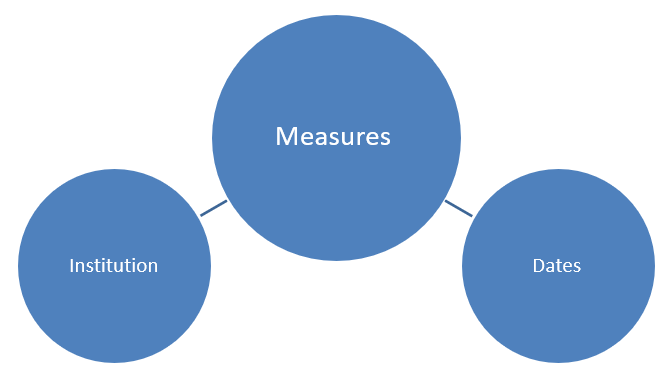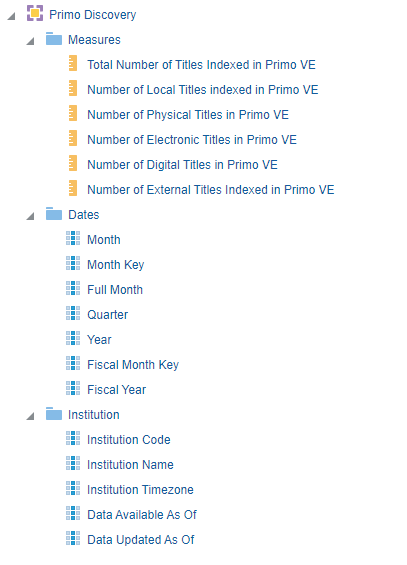Using the Primo Discovery area, the Design Analytics user may create reports/dashboards for the Primo Discovery area and is able to answer the following types of business questions:
- What is the total number of titles indexed in Primo VE?
- How many of the indexed titles are local?
- How many of the indexed titles are external?
- How many of the indexed titles are physical, electronic, or digital?
This data is collected once a month. The Data Available as of measure can be used to see when the data was last collected.
Star Diagram – Primo Discovery
Field Descriptions
The following fields are available in Primo Discovery.
Primo Discovery – Field Descriptions
Measures
The Measures table is a fact table that stores all measures relating to indexed titles.
-
These measures do not include titles that are suppressed from discovery.
-
In cases where active titles do not have any physical, digital, or electronic inventory, those items are calculated only under the Number of Local Titles Indexed in Primo VE measure and may explain why the sum of the Number of Physical Titles Indexed in Primo VE, Number of Electronic Titles Indexed in Primo VE, and Number of Digital Titles Indexed in Primo VE measures is not the same as the amount shown under the Number of Local Titles Indexed in Primo VE measure.
Measures
| Field |
Description |
Additional Information |
|
Total Number of Titles Indexed in Primo VE
|
The number of local and external titles indexed in Primo.
|
|
|
Number of Local Titles Indexed in Primo VE
|
The number of active local titles indexed in Primo.
|
|
|
Number of Physical Titles Indexed in Primo VE
|
The number of physical titles indexed in Primo, which includes the following:
- titles with active physical items
- titles with active physical items or holdings records
- titles with active holdings records and no items
|
|
|
Number of Electronic Titles Indexed in Primo VE
|
The number of electronic titles indexed in Primo, which includes the following:
- titles with active electronic portfolios
- titles with active electronic collections
|
|
|
Number of Digital Titles Indexed in Primo VE
|
The number of digital titles indexed in Primo, which includes titles with active digital representations.
|
|
|
Number of External Titles Indexed in Primo VE
|
The number of external titles indexed in Primo.
|
|
Dates
The Dates table is a dimension table that stores details about the bibliographic record creation date. Key fields are used whenever calculations are required. Description fields may be used for formatting the display of the report. Alma stores the following types of fields:
- Calendar Fields – These are date fields as they display in the calendar.
- Fiscal Date Fields – These are date fields that match the institution's fiscal period.
Dates
| Field |
Description |
Additional Information |
| Month |
Stores the month of the date in month description format such as February |
|
| Month Key |
Stores the month of the date in number format such as 2 for February |
This field is useful when you want to sort by the month, which does not work properly when using the alphabetical field. |
| Full Month |
Stores the month and the year of the date in a display format such as Feb 12 |
This field is useful when comparing data on a month basis between years. |
| Quarter |
Stores the quarter of the date in a display format such as Q1 |
|
| Year |
Stores the year of the date in number format such as 2012 |
|
| Fiscal Month Key |
Stores the fiscal month of the date in number format such as 2 for February |
This field is useful when you want to sort by the month, which does not work properly when using the alphabetical field. |
| Fiscal Year |
Stores the fiscal year of the date in a string format such as 2012. |
If the fiscal year description is stored in the institution fiscal period configuration table. This value is taken from there. |
Institution
The shared Institution dimension allows the Network Zone to view reports according to institution. If an analytics report is run from the Network Zone in a collaborative network implementing a Network Zone, all member institutions are included in the report for Institution Code and Institution Name. If an analytics report is run from an institution that is not part of a collaborative network implementing a Network Zone, only the single institution from which the report is run is included in the report for Institution Code and Institution Name.
Reports involving data across a collaborative network implementing a Network Zone may take longer to run than reports within one institution.
This dimension is available in every subject area. It contains the following fields:
Institution
| Field |
Description |
Additional information |
Data Type |
Data Size |
| Institution Code |
The code of the institution. |
Configured from: Configuration > General > Add a Library or Edit Library Information > Summary tab.
The label in Alma is Code located on the right pane.
|
VARCHAR |
50 |
| Institution Name |
The name of the institution. |
Configured from: Configuration > General > Add a Library or Edit Library Information > Summary tab.
The label in Alma is Organization unit name.
|
VARCHAR |
255 |
| Institution Address Line 1 |
The first line of the address of the institution. It usually includes the building number and the street name. |
Configured from: Configuration > General > Add a Library or Edit Library Information > Contact Information tab. This is taken from the address configured as the Preferred address.
The label in Alma is Address Line 1.
|
VARCHAR |
1000 |
| Institution City |
The city of the institution. |
Configured from: Configuration > General > Add a Library or Edit Library Information > Contact Information tab. This is taken from the address configured as the Preferred address.
The label in Alma is City.
|
VARCHAR |
255 |
| Institution State Province |
The state or province of the institution. |
Configured from: Configuration > General > Add a Library or Edit Library Information > Contact Information tab. This is taken from the address configured as the Preferred address.
The label in Alma is State/Province.
|
VARCHAR |
320 |
| Institution Country |
The country of the institution. |
Configured from: Configuration > General > Add a Library or Edit Library Information > Contact Information tab. This is taken from the address configured as the Preferred address.
The label in Alma is Country.
|
VARCHAR |
320 |
| Institution Postal Code |
The postal code of the institution. |
Configured from: Configuration > General > Add a Library or Edit Library Information > Contact Information tab. This is taken from the address configured as the Preferred address.
The label in Alma is Postal code.
|
VARCHAR |
200 |
| Institution Timezone |
The timezone of the institution. |
The timezone is set during implementation. |
VARCHAR |
255 |
| Data Available As Of |
When the institution data became available in analytics. |
Displayed at the bottom of the main Analytics menu. |
VARCHAR |
255 |
| Data Updated As Of |
When the institution data was taken from the Alma database. |
Displayed at the bottom of the main Analytics menu. |
VARCHAR |
255 |



